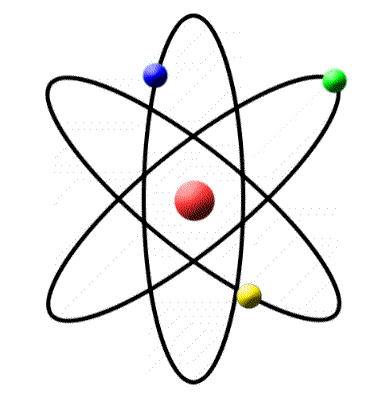As an electron makes a transition from an excited state to the ground state of a hydrogen- like atom/ion
- kinetic energy, potential energy and total energy decrease
- kinetic energy decreases, potential energy increases but total energy remains same
- kinetic energy and total energy decrease but potential energy increases
- its kinetic energy increases but potential energy and total energy decrease
The Correct Option is D
Solution and Explanation
$KE =\left| E _{\text {Total }}\right|$
$PE =2 \,E _{\text {total }}$
As n decreases, Total energy decreases, potential energy decreases and kinetic energy increases.
Top Questions on Atoms
- Prove that, in the Bohr model of the hydrogen atom, the time period of revolution of an electron in the \( n \)-th orbit is proportional to \( n^3 \).
- Describe the atomic model of Rutherford. How did Bohr model removed its drawbacks?
- Describe in brief, the \(\alpha\)-scattering experiment. Write down about the atomic-structure from the observation obtained from the experiment.
- What are the demerits of Rutherford model of an atom ?
- Assertion (A): The potential energy of an electron revolving in any stationary orbit in a hydrogen atom is positive.
Reason (R): The total energy of a charged particle is always positive.
Questions Asked in JEE Main exam
The motion of an airplane is represented by the velocity-time graph as shown below. The distance covered by the airplane in the first 30.5 seconds is km.

- JEE Main - 2025
- Kinematics
The least acidic compound, among the following is

- JEE Main - 2025
- Organic Chemistry
Choose the correct set of reagents for the following conversion:

- JEE Main - 2025
- Organic Chemistry

- JEE Main - 2025
- Organic Chemistry
- In a group of 3 girls and 4 boys, there are two boys \( B_1 \) and \( B_2 \). The number of ways in which these girls and boys can stand in a queue such that all the girls stand together, all the boys stand together, but \( B_1 \) and \( B_2 \) are not adjacent to each other, is:
- JEE Main - 2025
- Permutations
Concepts Used:
Atoms
- The smallest unit of matter indivisible by chemical means is known as an atom.
- The fundamental building block of a chemical element.
- The smallest possible unit of an element that still has all the chemical properties of that element.
- An atom is consisting of a nucleus surrounded by one or more shells of electrons.
- Word origin: from the Greek word atomos, which means uncuttable, something that cannot be divided further.
All matter we encounter in everyday life consists of smallest units called atoms – the air we breath consists of a wildly careening crowd of little groups of atoms, my computer’s keyboard of a tangle of atom chains, the metal surface it rests on is a crystal lattice of atoms. All the variety of matter consists of less than hundred species of atoms (in other words: less than a hundred different chemical elements).

Every atom consists of an nucleus surrounded by a cloud of electrons. Nearly all of the atom’s mass is concentrated in its nucleus, while the structure of the electron cloud determines how the atom can bind to other atoms (in other words: its chemical properties). Every chemical element can be defined via a characteristic number of protons in its nucleus. Atoms that have lost some of their usual number of electrons are called ions. Atoms are extremely small (typical diameters are in the region of tenths of a billionth of a metre = 10-10 metres), and to describe their properties and behaviour, one has to resort to quantum theory.